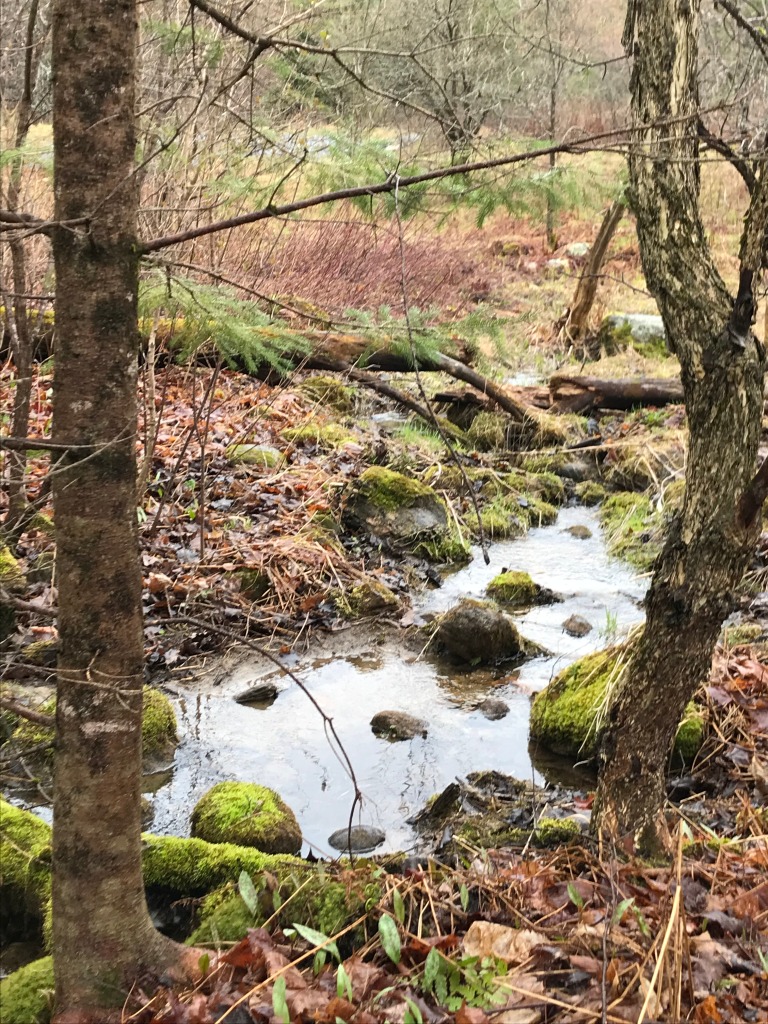There’s a little place in the woods near our cottage where I enjoy a peaceful moment and the natural beauty of Minden Hills, Ontario.
Let’s call it Kinross Creek.
The first time I came upon it, I had hiked up a steep hill along a hydro corridor north of Minden, Ontario.
The hydro line, high above Minden Lake, runs alongside hardwood forest, and through an abandoned farm and pasture. Massive stones of the Canadian shield protrude from the earth, and many pieces of stone have been tossed and scattered about by glaciers long ago.
Because there is no designated trail, and the going is a little steep, there is nobody up there except the birds and other creatures — like deer, whose trails crisscross under old maples, and follow time-tested routes through the forest.
At the beginning of April, the ground still had a crust of hard-packed snow, making it easy to get around, except for the odd time when my foot punched through the crust.
Kinross Creek was bubbling up from its headwaters next to a massive granite face. It meandered and burbled for a few hundred yards through a forest valley, then cascaded off a cliff. Below, it joined other small creeks flowing into Minden Lake.
In this area, the spring run-off is called “the freshet” — a time when the winter snow and ice thaws and flows into lakes and rivers. I believe Kinross Creek is one of those seasonal small rivers — it likely flows mostly during spring and perhaps after a heavy period of rainfall.
Getting to know you
My plan is to visit Kinross Creek throughout the season to get to know its annual cycle better, and to enjoy some of its natural surroundings.
And because I find its splashing and gurgling sounds soothing.
When I returned in late April, the snow had all gone and the creek was still running vigorously. I explored northwards a bit and found another section of the same creek — bubbling up as a spring and then draining into crevices under the massive granite shield.
Altogether the little creek, including its two sections above-ground, and its subterranean route under rock, is maybe 400 yards long. Its downstream section also collects water from a small forest valley.
Signs of spring
Before the trees had put on their leaves, trilliums were sprouting with their trios of green leaves. Their iconic white flowers were just beginning to open. Here and there, a patch of wild leeks created a green carpet on the forest floor. Robins pecked for worms, and a turkey vulture floated and circled on an air current above the hydro corridor.
I noticed that Kinross Creek had developed a couple of natural ponds along the way, from moss-covered fallen trees that partially blocked the flow of water. I decided to try to expand the ponds a little bit, and collected some nearby stone to be ready to do the work when the creek was drier in summer.
Besides the glacier-tossed bits of stone, I came across old stone piles placed there when the area had been farmed, perhaps a hundred years ago. Further along the hydro line, there is evidence of a cattle pasture. In the adjacent woods, there are the remains of a barbed-wire farm fence.
“Stone farmers”
It’s no understatement to call the people who once worked this land “stone farmers”. Year after year, they had to remove and pile stone to make their pasture or crop fields more productive. Before them, people of the Michi Saagiig and Chippewa Nations hunted, fished and trapped in this area.
The stones I had found would now help me enhance the water features of Kinross Creek — perhaps creating two slightly bigger ponds, and augmenting the little waterfall.
I would be that little kid again, messing around in his galoshes and using stones to divert a small stream and make a pond.

